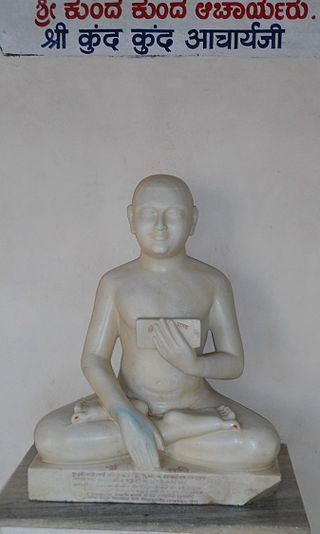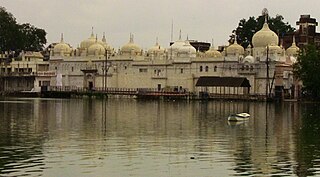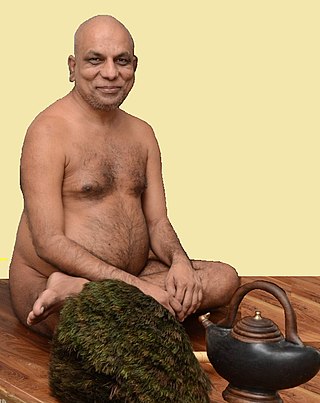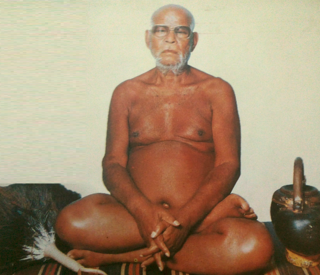Acharya Aryanandi was a prominent Jain monk of the early 20th century. He is best known for his work in establishing several Jain schools in the Indian state of Maharashtra. Several Jain monks before him have also been named Aryanandi.

Acharya Vidyasagar was an influential Indian Digambara Jain acharya (monk), credited with having brought about a revival in educational and religious activities in Digambara Jainism. He wrote the epic Hindi poem Mukamati.

Jain monasticism refers to the order of monks and nuns in the Jain community and can be divided into two major denominations: the Digambara and the Śvētāmbara. The monastic practices of the two major sects vary greatly, but the major principles of both are identical. Five mahāvratas, from Mahavira's teachings, are followed by all Jain ascetics of both the sects. Historians believe that a united Jain sangha (community) existed before 367 BCE, about 160 years after the moksha (liberation) of Mahavira. The community then gradually divided into the major denominations. However, no evidences indicate when the schism between the Digambaras and the Śvetāmbaras happened.

Acharya Shri Shantisagar Ji (1872–1955) was an Indian Acharya of the Digambara monk faith. He was the first Acharya (preceptor) and a leader of his digamber sect in the 20th century. Shanti Sagar ji revived the teaching and practice of traditional Digambara practices in North India. He was lustrated as a kshullaka into the Sangha by Devappa (Devakirti) Swami Ji. He took his ailaka deeksha before an image of the Tirthankara Neminatha. In about 1920, Shantisagar Ji became a full muni (sadhu) of the Digambara. In 1922, at Yarnal village, Belgaum district, Karnataka, he was given the name "Shanti Sagar Ji".
Sadalga is a municipal town in Chikodi Taluka in the Belagavi district of Karnataka, India. It is best known as the birth place of Digambar Jain Acharya Shri Vidyasagar Ji Maharaj. His home is recently converted into a museum.

Nemawar is a small town in Dewas District, Madhya Pradesh, India. Nemawar is located on the left bank of the Narmada river opposite to Handia. However, it belongs to Khategaon block and tehsil of the Dewas district

Acharya Vijay Vallabhsuri was a Jain monk. He was a disciple of Vijayanandsuri. He worked in Punjab so he was given honorific Punjab Kesari.

Anand Rishiji Maharaj was a Jain religious leader. The Government of India issued a commemorative postage stamp in his honour on 9 August 2002. He was awarded with the honorary title of Rashtra Sant by Maharashtra's chief minister. He was the Second Aacharya of Vardhaman Sthanakvasi Shraman Sangha

Jainism is an Indian religion which is traditionally believed to be propagated by twenty-four spiritual teachers known as tirthankara. Broadly, Jainism is divided into two major schools of thought, Digambara and Śvetāmbara. These are further divided into different sub-sects and traditions. While there are differences in practices, the core philosophy and main principles of each sect is the same.

Bara Mandir is a historic Jain temple in Jabalpur, India, right on the edge of Hanumantal, once the main center of Jabalpur.

Muni Tarun Sagar was an Indian Digambara monk. His lectures are termed Kadve Pravachan because they can be candidly critical of common practices and views. His lectures have been compiled and published in book series also titled Kadve Pravachan. Excerpts from his discourses are often published by newspapers. Unlike most other Digambar Jain monks, his audience often included a majority of non-Jains. His discourses often addressed family or society issues.

Ancient idols of Jain Tirthankara were found in archaeological expeditions in Badli, Bhiwani, Dadri, Gurgaon, Hansi, Hisar (Agroha), Kasan, Nahad, Narnaul, Pehowa, Rewari, Rohad, Rohtak and Sonepat in Haryana. Agrawal Jain community traces its origins from Hisar. Guptisagar Dham Tirtha at Ganaur is a religious tourist spot in Haryana. It is named after the Jain Acharya Guptisagar.

Munishri Pramansagarji Maharaj is a Digambar monk of Terapanth sub-sect. He is an able disciple of Acharya Shri Vidyasagar Ji Maharaj. He has set free the religion from traditional abstruseness and made it practicable in life. Through his sermons and initiatives, the process of a qualitative change in society has begun. He led a campaign to save the Jain tradition of Santhara also known as Sallekhana in the year 2015, in which millions of Jain community members took out massive silent rallies in several cities and towns all over the world against the Rajasthan High Court decision. Gunayatan is one of his important religious initiatives which is going to become a centre for self-development in the true sense. His pravachans and Shanka Samadhan programme are aired on Jinvani Channel and Paras TV Channel.

The Statue of Vasupujya located at Champapur,Bhagalpur in the Indian state of Bihar, is one of the tallest statues in eastern India and the tallest statue of Lord Vasupujya in India. The statue is dedicated to Vasupujya, the twelfth Jain Tirthankara of the present cosmic age. The height of the statue is 31 ft. The statue was constructed and donated by Smt Sona Devi Sethi Charitable trust, Nagaland. Champapur is a Siddhakshetra and occupies a very significant place among the Jains. This is said to be the place where all the five kalyanaks - Garbh, Janam, Diksha, Kevalgyana and Moksh kalyanak of Tirthankara Vasupujya took place. It is said that the first tirthankar Rishabha, twenty-third Tirthankara Parshvanath and last tirthankara Mahavira had their Chaturmas at this place. Mahavira had his third and twelfth Chaturmas at this place.

Acharya Deshbhushan was a Digambara Jain Acharya of 20th century who composed and translated many Kannada scriptures to Hindi and Sanskrit. He initiated and elevated several Jain monks and nuns like Shwetpichhi Acharya Vidyananda ji and Gyanmati Mataji. He is renowned for his remarkable translations of Kannada scriptures to Sanskrit and Hindi. He is the first Digambara Acharya to visit and address the Indian Parliament in the year 1974 along with the Prime Minister Indira Gandhi.

Muni Shri Sudhasagar Maharaj is a Digambar monk who was initiated by Acharya Shri Vidyasagar ji maharaj.

Muni Shri 108 Kshamasagar ji Maharaj was a Digambara monk initiated by Shri 108 Acharya Vidyasagar ji Maharaj. He is also known for his poetry and writings which are widely quoted.

Nainagiri is a major pilgrimage site for Jainism in India. It is located in the central Indian state of Madhya Pradesh, it is 12 km from Dalpatpur and 25 km from Bukswaha. This tirth, also known as Reshandigiri, is a Siddha Kshetra where five ancient saints including Varadatta had attained nirvana.

Daulatsagarsuri was a Jain ascetic, philosopher, and a revered saint belonging to the Śvetāmbara sect. He was the head of the monastic order (Gacchadhipati) of the "Sagar Samudaay" of the Tapa Gaccha. While he was alive, he was the preceptor of 900 monks and nuns. He was awarded the rarest of the rare and ancient title of "Shri Sangh Sthavir" based on his austerity, knowledge of the canonical scriptures of Jainism, and spiritual leadership, becoming the only second of the modern Jain ascetics to have achieved this feat.

















